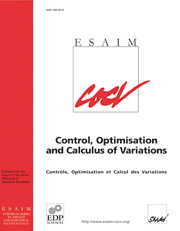Crossref Citations
This article has been cited by the following publications. This list is generated based on data provided by
Crossref.
Tchoń, Krzysztof
and
Jakubiak, Janusz
2006.
Extended Jacobian inverse kinematics algorithm for nonholonomic mobile robots.
International Journal of Control,
Vol. 79,
Issue. 8,
p.
895.
Muller, Bernhard
Deutscher, Joachim
and
Grodde, Stefan
2007.
Continuous Curvature Trajectory Design and Feedforward Control for Parking a Car.
IEEE Transactions on Control Systems Technology,
Vol. 15,
Issue. 3,
p.
541.
Tchon, Krzysztof
and
Malek, Lukasz
2009.
On Dynamic Properties of Singularity Robust Jacobian Inverse Kinematics.
IEEE Transactions on Automatic Control,
Vol. 54,
Issue. 6,
p.
1402.
Chitour, Yacine
Jean, Frederic
and
Long, Ruixing
2009.
A global steering method for general dynamical nonholonomic systems.
p.
27.
Amiss, Scott C.
and
Guay, Martin
2009.
A necessary condition for path-finding by the homotopy continuation method.
p.
2117.
Jakubiak, Janusz
Tchoń, Krzysztof
and
Magiera, Władysław
2010.
Motion planning in velocity affine mechanical systems.
International Journal of Control,
Vol. 83,
Issue. 9,
p.
1965.
Tchoń, K.
Jakubiak, J.
and
Małek, Ł.
2010.
Advances in Robot Kinematics: Motion in Man and Machine.
p.
11.
Alouges, François
Chitour, Yacine
and
Long, Ruixing
2010.
A Motion-Planning Algorithm for the Rolling-Body Problem.
IEEE Transactions on Robotics,
Vol. 26,
Issue. 5,
p.
827.
Amiss, Scott C.
and
Guay, Martin
2010.
On the endpoint maps of fully nonlinear control systems that use locally L<sup>p</sup> controls.
p.
2716.
Lini, Gabriele
Piazzi, Aurelio
and
Consolini, Luca
2011.
Multi-optimization of η<sup>3</sup>-splines for autonomous parking.
p.
6367.
Karpinska, Joanna
and
Tchon, Krzysztof
2011.
Continuation method approach to trajectory planning in robotic systems.
p.
51.
Janiak, Mariusz
and
Tchoń, Krzysztof
2011.
Constrained motion planning of nonholonomic systems.
Systems & Control Letters,
Vol. 60,
Issue. 8,
p.
625.
Amiss, Scott C.
and
Guay, Martin
2011.
Intrinsic Quadratic Differentials of the Endpoint Maps of Nonlinear Systems With Lp Controls.
IFAC Proceedings Volumes,
Vol. 44,
Issue. 1,
p.
13351.
Amiss, Scott C.
and
Guay, Martin
2012.
Motion planning by the homotopy continuation method for control-affine systems: Sublinear growth conditions.
p.
991.
Karpińska, Joanna
Tchoń, Krzysztof
and
Janiak, Mariusz
2012.
Approximation of Jacobian Inverse Kinematics Algorithms: Differential Geometric vs. Variational Approach.
Journal of Intelligent & Robotic Systems,
Vol. 68,
Issue. 3-4,
p.
211.
Caillau, J.-B.
and
Daoud, B.
2012.
Minimum Time Control of the Restricted Three-Body Problem.
SIAM Journal on Control and Optimization,
Vol. 50,
Issue. 6,
p.
3178.
Amiss, S. C.
and
Guay, M.
2012.
Motion planning by the homotopy continuation method for control-affine systems.
p.
1767.
Chitour, Yacine
Jean, Frédéric
and
Long, Ruixing
2013.
A global steering method for nonholonomic systems.
Journal of Differential Equations,
Vol. 254,
Issue. 4,
p.
1903.
Jean, Frédéric
2014.
Control of Nonholonomic Systems: from Sub-Riemannian Geometry to Motion Planning.
p.
59.
Ratajczak, Adam
and
Tchoń, Krzysztof
2015.
Parametric and Non-parametric Jacobian Motion Planning for Non-holonomic Robotic Systems.
Journal of Intelligent & Robotic Systems,
Vol. 77,
Issue. 3-4,
p.
445.


